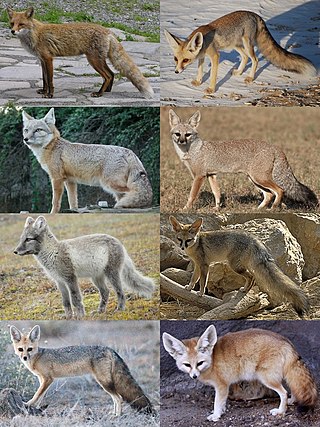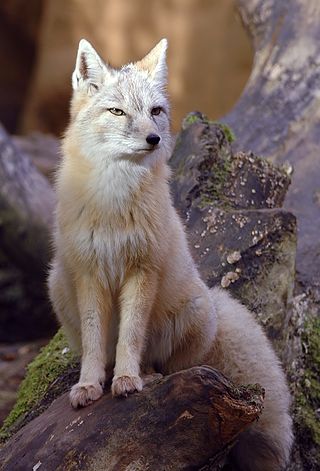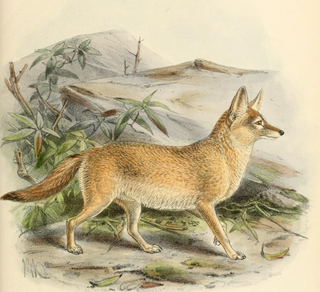
Vulpes is a genus of the sub-family Caninae. The members of this genus are colloquially referred to as true foxes, meaning they form a proper clade. The word "fox" occurs in the common names of all species of the genus, but also appears in the common names of other canid species. True foxes are distinguished from members of the genus Canis, such as domesticated dogs, wolves, jackals and coyotes, by their smaller size (5–11 kg), longer, bushier tail, and flatter skull. They have black, triangular markings between their eyes and nose, and the tip of their tail is often a different color from the rest of their pelt. The typical lifespan for this genus is between two and four years, but can reach up to a decade.

The Chinese mountain cat, also known as Chinese desert cat and Chinese steppe cat, is a small wild Felis species with sand-coloured fur, faint dark stripes on the face and legs and black tipped ears. It is endemic to the Tibetan Plateau of western China, where it lives in grassland above elevations of 2,500 m (8,200 ft). It has been listed as vulnerable on the IUCN Red List since 2002.

Blanford's fox is a small fox native to the Middle East and Central Asia. It is listed as Least Concern on the IUCN Red List.

Ladakh is the home to endemic Himalayan wildlife, such as the bharal, yak, Himalayan brown bear, Himalayan wolf and the iconic snow leopard. Hemis National Park, Changthang Cold Desert Wildlife Sanctuary, and Karakorum Wildlife Sanctuary are protected wildlife areas of Ladakh. The Mountain Institute, the Ladakh Ecological Development Group and the Snow Leopard Conservancy work on ecotourism in rural Ladakh. For such an elevated, arid area, Ladakh has great diversity of birds — 318 species have been recorded. Many of these birds reside at or seasonally breed in high-altitude wetlands, such as Tso Moriri, or near rivers and water sources.

The corsac fox, also known simply as a corsac, is a medium-sized fox found in steppes, semi-deserts and deserts in Central Asia, ranging into Mongolia and northern China. Since 2004, it has been classified as least concern by IUCN, but populations fluctuate significantly, and numbers can drop tenfold within a single year. It is also known as the steppe fox. The word "corsac" is derived from the Russian name for the animal, "korsák" (корса́к), derived ultimately from Turkic "karsak".

The pale fox is a species of fox found in the band of African Sahel from Senegal in the west to Sudan in the east. It is one of the least studied of all canid species, in part due to its remote habitat and its sandy coat that blends in well with the desert-like terrain.

The Himalayan wolf is a canine of debated taxonomy. It is distinguished by its genetic markers, with mitochondrial DNA indicating that it is genetically basal to the Holarctic grey wolf, genetically the same wolf as the Tibetan and Mongolian wolf, and has an association with the African wolf. No striking morphological differences are seen between the wolves from the Himalayas and those from Tibet. The Himalayan wolf lineage can be found living in Ladakh in the Himalayas, the Tibetan Plateau, and the mountains of Central Asia predominantly above 4,000 m (13,000 ft) in elevation because it has adapted to a low-oxygen environment, compared with other wolves that are found only at lower elevations.

The Caninae, known as canines, are one of three subfamilies found within the canid family. The other two canid subfamilies are the extinct Borophaginae and Hesperocyoninae. The Caninae includes all living canids and their most recent fossil relatives. Their fossils were first found in North America and dated to the Oligocene era, then spreading to Asia at the end of the Miocene era, some 7 million to 8 million years ago.

The upland buzzard is a species of bird of prey in the family Accipitridae. The largest species of the Buteo genus, this buzzard lives in mountainous grassy and rocky areas in areas of Central Asia, northern South Asia and East Asia from Kazakhstan to Korea. The upland buzzard is migratory but typically covers a short distance apparently to avoid snow cover that may hamper prey capture. This species primarily subsists on small mammals but does not shun alternate prey from small to large birds and insects. This little known raptor has a large range, and though generally uncommon, it is not thought to be rare or declining as a species. As a result it is classified as least concern by the IUCN.

The plateau pika, also known as the black-lipped pika, is a species of mammal in the pika family, Ochotonidae.

The Ladak pika, also known as the Ladakh pika, is a species of mammal in the family Ochotonidae found in China, India, and Pakistan. Prior to identification as a separate species, specimens were thought to be of the plateau pika. Named for the Ladakh region, they are commonly found in valleys of the mountain ranges spanning from Pakistan through India to China at an elevation between 4,300 and 5,450 m and are herbivores.

The Moupin pika, also known as Ribetischer Pika, Moupin-Pika, Pika del Tibet, and Manipuri pika, is a species of mammal in the pika family, Ochotonidae. It has many subspecies, some of which may be distinct species. Its summer pelage is dark russet-brown with some light spots on the dorsal side, and ochraceous buff tinged on the belly. In winter it is lighter, with buff to dull brown dorsal pelage. A generalist herbivore, it is found in the mountains of the eastern Tibetan Plateau in China, Bhutan, India (Sikkim), and northern Myanmar. Both the International Union for Conservation of Nature Red List of Endangered Species and the Red List of China's Vertebrates classify it as a species of least concern; although one subspecies may be endangered.

There are at least 14 large mammal and 50 small mammal species known to occur in Glacier National Park.

The Mongolian wolf is a subspecies of gray wolf which is native to Mongolia, northern and central China, Korea, and the Ussuri region of Russia.
















